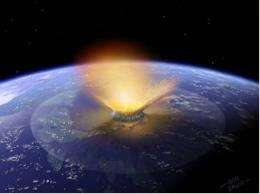October 27, 2010 report
Asteroid strike into ocean could deplete ozone layer

(PhysOrg.com) -- Scientists in Texas say if a medium-sized asteroid were to crash into the ocean the ozone layer could be depleted, allowing high levels of ultraviolet radiation to reach the surface.
Dr. Elisabetta Pierazzo and colleagues from the Planetary Science Institute in Tucson ran computer simulations that revealed if an asteroid 500 m to 1 km in diameter were to hit the Pacific Ocean it would eject enough water vapor and sea salt high enough into the atmosphere to affect the protective ozone layer.
The results of the simulations showed the 1 km asteroid could affect an area over 1000 km in diameter, and vast quantities of water and vapor would be ejected up to 160 km high. The scientists say the water vapor would contain chlorine and bromine from the vaporized sea salts, and this would result in significant global depletion of the ozone layer by destroying it faster than it is created naturally. Pierazzo said such an asteroid would produce “an ozone hole that will engulf the entire Earth,” and produce a huge spike in ultraviolet (UV) radiation with levels higher than anywhere on the surface today.
The simulations showed the smaller asteroid, 500 meters across, could produce ultraviolet index (UVI) levels of 20 or over in the northern tropics for a period of several months, and the global ozone depletion would be similar to the record ozone holes seen over the Antarctic in the mid 1990s. The 1 km asteroid could produce a spike of 56, and levels over 20 for about two years in both the northern and southern hemispheres. The UVI is a measure of UV intensity, with levels over 10 assumed dangerous. The highest recorded UVI known in recent times has been 20.
Pierazzo said previous studies of the effects of asteroid impacts on the ocean have concentrated on tsunamis, but her research found the effects of a medium-sized asteroid strike would also include difficulty in growing crops and would have a long-term negative effect on global food production. She said if there was enough warning of an impending strike farmers could plant crops with high UV-tolerance and food could be stored to ensure supplies during the period of low productivity.
Other effects would include increased rates of skin cancer and cataracts. People may also have to avoid exposure to direct sunlight to avoid rapid sunburn. A UVI level of 56 has never been experienced, and so the effects are uncertain, but it is likely that people would have to remain indoors during daylight to avoid serious sunburn.
The study said over 100 asteroids 1 to 2 km in diameter are thought to be orbiting in paths that could bring them near to Earth, and many more smaller asteroids appear to be “currently looming undiscovered in the Earth’s neighborhood.” NASA estimates there are around 800 such Near Earth Objects (NEOs). The authors say past research suggests on average an asteroid 500 meters wide or less hits the Earth about once every 200,000 years, while a larger asteroid strike happens around once every 800,000 years.
The research covered only the impact of an asteroid hitting the ocean, since such strikes are twice as likely to occur as land impacts. The results are published in the journal Earth and Planetary Science Letters.
More information: E. Pierazzo et al., Ozone perturbation from medium-size asteroid impacts in the ocean, Earth and Planetary Science Letters, Article in Press, doi:10.1016/j.epsl.2010.08.036
© 2010 PhysOrg.com



















